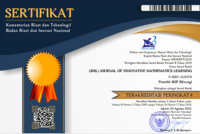Analysis of Mathematical Creative Thinking Ability on Junior High School Students in Bandung
DOI:
https://doi.org/10.22460/jiml.v6i2.15257Keywords:
Mathematics, Creative Thinking Ability, Junior High SchoolAbstract
This research is motivated by the importance of quadrilateral material in mathematics lessons, especially for students as an educational subject in everyday life, while the aim is to analyze students’ mathematical creative thinking abilities in solving quadrilateral problems. This research is a qualitative descriptive study. The population in this study were all seventh-grade junior high school students in the city of Bandung whose sample was randomly selected at Paulus Middle School as many as 32 people. Students can be classified based on their creative thinking abilities based on (1) the Ability creative thinking of students with the high category is fulfilling 3 indicators of creative thinking namely fluency, flexibility, and novelty, so students with the high category is said to be creative. (2) Students' ability to think creatively with the medium category is fulfilling 2 indicators of creative thinking, namely fluency and flexibility, so students in the medium category are said to be not creative. (3) The creative thinking ability of students in the low category is fulfilling 1 indicators of creative thinking are fluency and students in the moderate category said students who are not creative. Data is obtained by testing creative thinking test questions as many as 4 questions that contain indicators. The results showed that there were 2 people with high ability, 4 people with moderate ability, and 26 people with low ability with various errors including conceptual errors, principal errors, and data operation errors. Based on this, it can be concluded that the creative thinking skills of junior high school students are still relatively low.
References
Alifah, N., & Amir, N. F. A. F. A. Students’ Creative Thinking Ability in Solving Problems in Middle School Triangle and Quadrilateral Materials.
BSNP. (2006). Regulation of the Minister of National Education of the Republic of Indonesia Number 22 of 2006 concerning Content Standards for Elementary and Secondary Education Units.
Dalilan, R., & Sofyan, D. (2022). Middle School Students’ Mathematical Creative Thinking Ability in terms of Self Confidence. Plusminus: Journal of Mathematics Education, 2(1), 141-150.
Faturohman, I., & Afriansyah, E. A. (2020). Improving Students’ Mathematical Creative Thinking Ability through Creative Problem Solving. Mosharafa: Journal of Mathematics Education, 9(1), 107-118.
Kamalia, N. A., & Ruli, R. M. (2022). ANALYSIS OF JUNIOR HIGH SCHOOL STUDENTS’ MATHEMATICAL CREATIVE THINKING ABILITY IN FLAT BUILDING MATERIALS. Journal of Mathematics Education and Science(JES-MAT), 8(2), 117-132.
Kurniawan, A., & Setiawan, D. (2019). The Effectiveness of the Inquiry Learning Model on Students' Creative Thinking Ability in Pythagorean Theorem Material. Journal Scholar: Journal of Mathematics Education,2(5), 271–282.
Lesi, A. N., & Nuraeni, R. (2021). Differences in Students’ Mathematical Problem-Solving Ability and Self-Confidence between the TPS and PBL Models. Plusminus: Journal of Mathematics Education, 1(2), 249-262.
National Research Council. (1989). Everybody Counts. A Report to the Nation on the Future of Mathematics Education. Washington: National Academy Press.
Romika & Amalia, Y. (2014). Analysis of Students’ Mathematical Problem Solving Ability on Flat Sided Space Construct Material with Van Hiele Theory. Bina Gogik,1(2), 17–31
Rozi, F. A., & Afriansyah, E. A. (2022). Analysis of mathematical creative thinking abilities based on students’ mathematical dispositions. Journal of Authentic Research on Mathematics Education (JARME), 4(2), 172-185.
Torrance, P.E. (1981). A Three-Stage Model Teaching for Creative Thinking. Dalam A. E. Lawton (Editor) Science Education Information Report. Columbus, Ohio: The Eric Science, Mathematics and Environmental Education Clearing House, 226-253.
Torrance, P.E. (1981). A Three-Stage Model Teaching for Creative Thinking. Dalam A. E. Lawton (Editor) Science Education Information Report. Columbus, Ohio: The Eric Science, Mathematics and Environmental Education Clearing House, 226-253.
Sternberg R. (2013). Teaching For Successful Intelligence: Teaching Success Intelligence Increases Student Learning and Success, (Translator: Mardiatmoko. G, Yogyakarta: Pustaka Pelajar)
Sukmadinata, N. S. (2012). Curriculum and Competency Learning, (Bandung : Kusuma Karya)
Ulandari, N., Putri, R., Ningsih, F., & Putra, A. (2019). The Effectiveness of the Inquiry Learning Model on Students’ Creative Thinking Ability in Pythagorean Theorem Material. Scholar’s Journal: Journal of Mathematics Education, 03(02), 227–237.

























